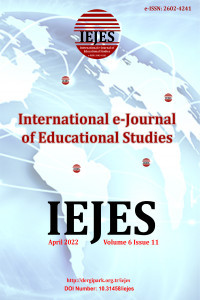Examining the Learning Styles of Teacher Candidates in Terms of Different Variables
Kolb learning style, learning, learning style, pre-service teacher
Examining the Learning Styles of Teacher Candidates in Terms of Different Variables
Kolb learning style, learning, learning style, pre-service teacher,
___
- Akgün, İ. (2002). Learning styles of the students in private English courses, Unpublished Master’s Thesis, Hacettepe University, Institute of Social Sciences, Ankara.
- Altun, H., & Yılmaz, S. (2016). İlköğretim matematik öğretmenliği lisans öğrencilerinin türev konusundaki akademik başarıları ile öğrenme stilleri arasındaki ilişkilerin incelenmesi [Investigation of the relationship between academic achievement with learning styles towards the derivative of elementary mathematics teaching undergraduate students]. Batı Anadolu Eğitim Bilimleri Dergisi, 7(13), 161-182.
- Arsal, Z. & Özen, R. (2007). Sınıf öğretmeni adaylarının öğrenme stratejileri ve öğrenme biçimi tercihlerinin incelenmesi [Examining the learning strategies and learning style preferences of candidate classroom teachers]. AİBÜ Eğitim Fakültesi Dergisi, 7(2),151-164.
- Aşkar, P. & Akkoyunlu, B. (1993). Kolb öğrenme stili envanteri, [Kolb learning style inventory]. Eğitim ve Bilim, 87, 37–47.
- Biggs, J. (2001). Enhancing learning: A matter of style or approach?. Lawrence Erlbaum Associates Publishers. Büyüköztürk, Ş. (2002). Faktör analizi: Temel kavramlar ve ölçek geliştirmede kullanımı [Factor analysis: Basic concepts and using to development scale]. Kuram ve Uygulamada Eğitim Yönetimi, 32(32), 470-483.
- Can, Ş. (2011). Investigation of the relationships between the learning styles and preservice elementary teachers and some variables. Hacettepe University Journal of Education Faculty, 41, 70-82.
- Durdukoca, Ş. F. & Arıbaş, S. (2010). İnönü üniversitesi eğitim fakültesi sınıf öğretmenliği öğretmen adaylarının sahip oldukları öğrenme stillerinin farklı değişkenlere göre değerlendirilmesi [The evaluation of the learning styles that the teacher candidates of Inonu university, faculty of education, department of prımary school teaching have according to different variables ]. Bildiriler kitabı (s:517-523), 9. Ulusal Sınıf Öğretmenliği Eğitimi Sempozyumu, Elazığ.
- Ekici, G. (2003). Öğrenme stiline dayalı öğretim ve biyoloji dersi öğretimine yönelik ders planı örnekleri [Course plan examples for learning style-based teaching and biology course teaching] (1. Baskı). Ankara: Gazi Kitabevi.
- Given, B. K. (1996). Learning styles: A synthesized model. Journal of Accelerated Learning and Teaching. Special Issue 21, (11- 44).
- Gregorc, A. F., & Butler, K. A. (1984). Learning is a matter of style. VocEd, 59(3), 27-29.
- Güneş, C. (2004). Learning styles of Gazi University preparatory class, Unpublished Master’s Thesis, Gazi University, Institute of Educational Sciences, Ankara.
- Kaf-Hasırcı, O. (2006). Sınıf öğretmenliği öğrencilerinin öğrenme stilleri: Çukurova üniversitesi örneği. [Learning styles of prospective primary school teachers: Çukurova university case]. Eğitimde Kuram ve Uygulama Dergisi 2(1), 15-25.
- Karasar, N. (2012). Bilimsel araştırma yöntemi [Scientific research methods]. Ankara, Nobel Yayın.
- Kolb, D. A., Boyatzis, R. E., & Mainemelis, C. (2001). Experiential learning theory: Previous research and new directions. Perspectives on thinking, learning, and cognitive styles, 1(8), 227-247.
- Kolb, D. A. (1984). Experimential learning: Experience as the source of learning and development. Englewood Cliffs, NJ: Prentice- Hall.
- Kolb, D. A. (1985). Learning style inventory: Self-scoring inventory and interpretation booklet. Boston: McBer and Company.
- Kolb, A. Y., & Kolb, D. A. (2005) The kolb learning style inventory-version 3.1 2005 Thecnical Specification, Boston, MA:Hay Group Resources Direct.
- Kılıç, E. (2002). Baskın öğrenme stilinin öğrenme etkinlikleri tercihi ve akademik başarıya etkisi. [The effect of the dominant learning style on learning activities preference and academic achievement]. Eğitim Bilimleri ve Uygulama, 1(1), 1-15.
- Özbay, M. (2006). Türkçe özel öğretim yöntemleri I. [Turkish Private Teaching Methods I]. Ankara: Öncü Kitap.
- Özer, B. (1998). Eğitim bilimlerinde yenilikler. [Innovations in educational sciences]. (Ed. H. Ayhan), Öğrenmeyi öğretme [Teaching learning]. (s.146-164), Anadolu Üniversitesi Açıköğretim Fakültesi Yayınları.
- Özgür, H. (2013). Learning styles of distance education students: Trakya university sample. Trakya University Journal of Education Faculty, 3(2), 85-91.
- Özsoy, N., Yağdıran, E. & Öztürk, G. (2004). Onuncu sınıf öğrencilerinin öğrenme stilleri ve geometrik düşünme düzeyleri. [Tenth grade students’ learning styles and their geometric thinking levels]. Eğitim Araştırmaları, 16, 50-63.
- Stice, J. E. (1987). Using kolb's learning cycle to improve student learning. Engineering Education, 77(5), 291-96.
- Vural, B. (2004). Eğitim-öğretimde planlama-ölçme ve stratejiler. [Planning, measurement and strategies in education]. İstanbul: Bilge Matbaacılık.
- Whitcomb, R. M. (1999). The relationship between student cognitive development and learning style preference. Unpublished doctoral thesis The University of Maine.
- White, J. (1994). Individual characteristics and social knowledge in ethical reasoning, Psychological Reports, 75, 627-649.
- Başlangıç: 2017
- Yayıncı: Tamer KUTLUCA
Yusuf ALPDOĞAN, Semra OMAK, Müzeyyen ELDENİZ ÇETİN
Development of Turkish Reading Anxiety Scale
Suleyman KASAP, Mahmut AYAZ, Mehmet Sena ATAŞ
An Ontological Study on Proof: If and only If Propositions
Peer Bullying Experiences and Management Strategies of Preschool Teachers
Examining the Learning Styles of Teacher Candidates in Terms of Different Variables
